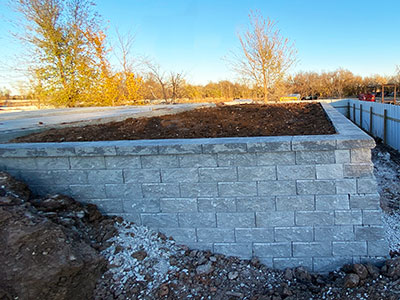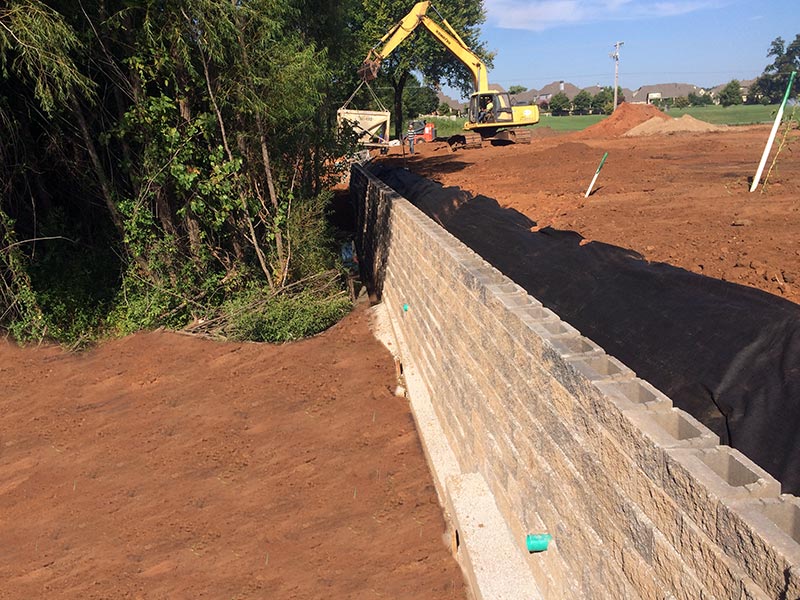Precast Block Retaining Walls
Our company was founded on the idea that grading land and installing retaining walls can turn unproductive land into useable space. You may own or want to buy land in an area with insufficient flat or gradually sloping ground to build your structure or use for your desires. We are here to help.


There are critical steps that must be followed for a precast block retaining wall to last.
The base block is the most crucial block that will be placed on your wall. It must be level in all directions and aligned with the other blocks. The second critical item is, we are building a retaining wall… not a dam. The number one reason a wall fails is hydrostatic pressure. A properly installed French drain and behind-the-wall water management is critical for any retaining wall to pass the test of time.
A basic precast retaining wall principle is the block does not hold the dirt up. The soil holds the wall up, and the block holds the dirt back. With the entire system of the French drain, geogrid soil reinforcement, compaction of the soil, and the blocks installed properly, the wall should last longer than any of us. Without all the aspects being properly addressed, a wall is doomed to fail.



Six steps to building a precast block retaining wall.
1
Contact 811
Building the retaining wall always starts with us contacting the state locating service to avoid damaging any buried utilities. This simple required step avoids potentially catastrophic injuries to life and possessions.
Disturbing the Land
Check that grading is within an inch or two of the land’s ultimate grade. We don’t expect the ground to be final graded, since we will disturb it while we do our work. The land will be disturbed during the wall’s installation. No “collateral damages” to any trees, structures, or surfaces should be expected unless they have been discussed and agreed upon in writing.
Installing the Leveling Pad
We typically require commercial project layouts to be done by others. We work directly with homeowners to be sure we are doing what they want by making any final adjustments before we start digging the site. We paint the leveling pad’s path on the ground and place offset markers to retain the path once the path has been dug. The typical SRW pad is 6″ thick and 2′ wide. The typical modular block pad is 1′ thick and 2′ wider than the bottom block. The leveling pad is typically a DOT aggregate road base… sometimes around waterways it will be a concrete footing.
Building the Wall
Once the base block is set, the wall is ready to be stacked. This portion of its installation gets the French drain installed, geogrid placed as it is designed, and the cap adhered. The installation of all these things plus the proper backfill material compacted to specifications is critical to its aesthetics and durability.
5
The Finishing Touches
There shouldn’t be any dirt to clean from the wall except the dust carried by the wind, if it is on a new construction project. There shouldn’t be any visible chips on the blocks that aren’t from being split-faced blocks. This is when PGMC is completed with commercial projects. If a residential customer requires an irrigation system, sod installation, or a fence or railing, we can assist our customers with their needs. You should be able to inspect your new wall and view it like a piece of art, worthy to behold and enjoy for decades into the future.
6
Maintaining Your Retaining Walls
Maintain healthy sod or hard surfaces. Don’t let waterways hit your PGMC retaining wall unless it has been specifically designed for that useage. Gutter and downspout drain lines should be maintained. Water and erosion control determine the success of any retaining wall. Finally, avoid using heavy machinery near the wall, especially in wet conditions. The equipment can apply lateral pressure from further away than expected.
